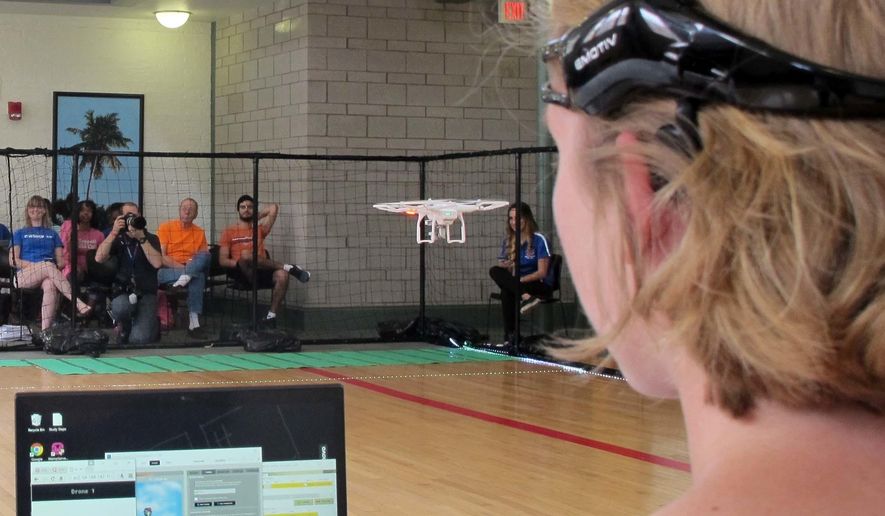The Pentagon’s information warfare experts are warning about brain hacking, a technology capable of extracting and inserting information into minds.
The effort to turn humans into X-men seems no longer science fiction.
Indeed, an international race is underway to perfect brain machine interfaces that turn people into Professor X-like superhumans capable of controlling devices with their thoughts.
Brain machine interfaces, or BMI, also called brain computer interfaces, allow for a direct link between a brain’s electrical signals and a device that processes them to complete a task.
China says it has used the technology to make “mind reading” possible, and two U.S.-based scientists have demonstrated the ability to insert false memories into mice.
“No emerging technology is potentially more important to the military,” Lt. Cmdr. Mark Wess, a cryptologic warfare officer, wrote in the May issue of the U.S. Naval Institute’s magazine Proceedings.
SEE ALSO: China is ‘light years ahead’ of U.S. in monitoring foreign tech, ex-CIA officer warns
Cmdr. Wess envisioned a world where fellow naval officers use the technology to control a battleship’s navigation, weapons and engineering systems and “make the ship come to life through thought alone.”
China and Russia are more likely than the U.S. to rapidly adopt the technology for their fighting forces with little concern for the machines’ reversibility and people’s well-being, Cmdr. Wess said.
He encouraged Americans to consider the threat of the technology, particularly if it advances to include a complete mapping of brains so that neurons can be attached to memories.
“Can a person’s BMI be hacked to extract information from a mind?” Cmdr. Wess wrote. “Could someone be interrogated merely by hooking them up to a BMI?”
Whether the military has answers to these questions is not clear, but it is investigating the technology’s potential application.
After agreeing to an interview with The Washington Times, Cmdr. Wess called it off, citing orders from Defense Department officials.
The U.S. government has studied whether brain technology would be a more effective lie detector than traditional interrogation methods and polygraphs.
The Department of Defense has funded deception detection studies looking at brain activity through neuroimaging, according to Capt. Ayesha Ahmad’s 2021 master’s thesis for the Naval Postgraduate School.
Capt. Ahmad reviewed the military’s previous neuroimaging experiments using electroencephalograms, which measure the brain’s electrical activity. She reported that the U.S. Navy used EEGs to classify deception with a median 95% statistical confidence and an error rate below 1%.
She proposed a solution to advance the military’s capabilities that she labeled the Warfare Integrated Lie Detection System (WILDS). Capt. Ahmad’s sensors would measure electrical signals within the brain, blood flow to the brain, body temperature, heart rate and other inputs to get the truth out of U.S. enemies.
The Pentagon has not made public whether it has plans for Capt. Ahmad’s system.
Shannon Houck, Capt. Ahmad’s thesis adviser at the Naval Postgraduate School, said Capt. Ahmad might be deployed. After agreeing to an interview, Ms. Houck later abruptly declined to talk.
U.S. competitors also want to produce the brain technology. China’s Tianjin University and China Electronics Corp. said in 2019 that they created a Brain Talker device capable of decoding mental intent through electrical signals.
China Electronics data scientist Cheng Longlong said the technology would be used for medical treatment, education, security and self-discipline, among other things, according to an English-language translation of the May 2019 announcement.
Three days after China touted its device, the U.S. Defense Department’s research and development arm published new details of its Next-Generation Nonsurgical Neurotechnology program.
The Defense Advanced Research Projects Agency program started in 2018 with hopes of making wearable interfaces that could control swarms of unmanned aerial vehicles, commonly known as drones.
Alongside using emerging technology to extract information from minds and control external devices, researchers are hard at work understanding how technology may be used to insert knowledge into a brain.
U.S.-based scientists created a false memory in the mind of a mouse after identifying the brain cells responsible for encoding memories. The scientists used lasers to activate the rodent’s brain cells and implant a false memory. After the results were published 10 years ago, Smithsonian Magazine hailed the research as a neuroscience breakthrough.
Military officers expressed an interest in applying the technology to animals in the short term and humans in the long term.
Air Force Maj. Mark W. Vahle wrote about the mice experiments in 2019 and said increased investment in brain technology in the next five to 20 years may lead to socially acceptable deployment for “remote animal control.”
“These advances open a range of possibilities for increasing the use of animals in the military,” Maj. Vahle wrote for the Air Command and Staff College. “Military applications include payload delivery, like the attempts during WWII to utilize pigeons and bats to deliver munitions, conduct reconnaissance and search and rescue, and detect explosives.”
Brain machine interface is not limited to combat and espionage.
Modern medicine is anticipating a boost from the technology. In August, two research teams published results from studies using brain implants and artificially intelligent algorithms to allow paralyzed people to communicate.
A woman who lost her ability to speak 18 years ago because of a stroke used the brain technology to talk with a replication of her voice through a digital avatar of herself, according to MIT Technology Review.
To demystify the brain computer interface and allow people to view its applications, the American Association for the Advancement of Science is hosting an exhibit of the brain technology in its Washington offices through Nov. 15.
The exhibit documents the advancements in brain technology and shows digital art created by paralyzed patients who used a Blackrock Neurotech brain implant and software programs such as Microsoft Paint and Photoshop.
The AAAS and Blackrock Neurotech display includes a section on future uses of the technology and says trials are underway for “new areas of function restoration such as hearing and sight” to make the blind see and deaf hear, among other breakthroughs.
Blackrock Neurotech is working toward “whole-brain data capture” and expects its first product to become available for home use next year.
Home use does not mean the brain implants will be available off the shelf anytime soon, AAAS’ Olga Francois said.
“I don’t think the technology is there yet,” Ms. Francois said. “Walking into a Best Buy and [buying an] Oculus is not this.”
Billionaire technology mogul Elon Musk may look to change that. In September, Mr. Musk’s Neuralink began recruiting human patients to test its brain computer interface technology after receiving Food and Drug Administration approval to proceed in May.
Neuralink said the goal of its first human trial is to allow people to move a computer cursor and type on a keyboard using only their thoughts.
• Ryan Lovelace can be reached at rlovelace@washingtontimes.com.




Please read our comment policy before commenting.